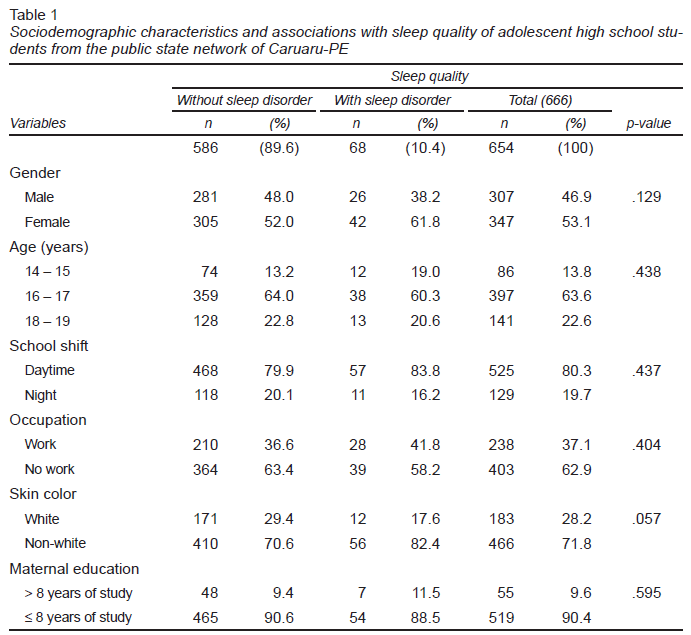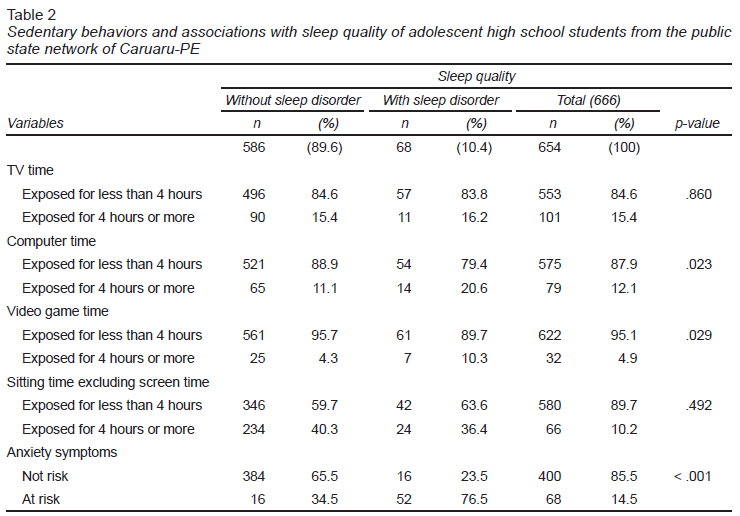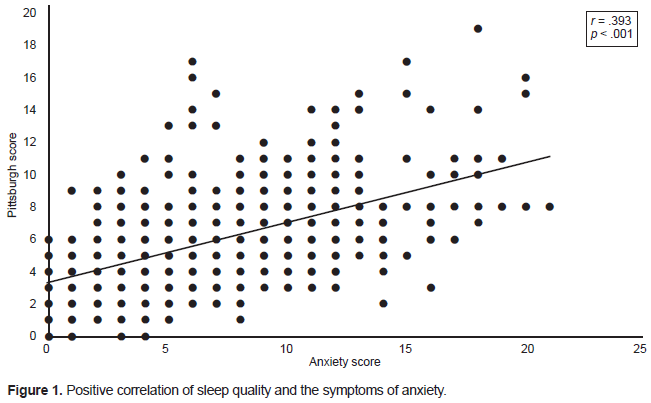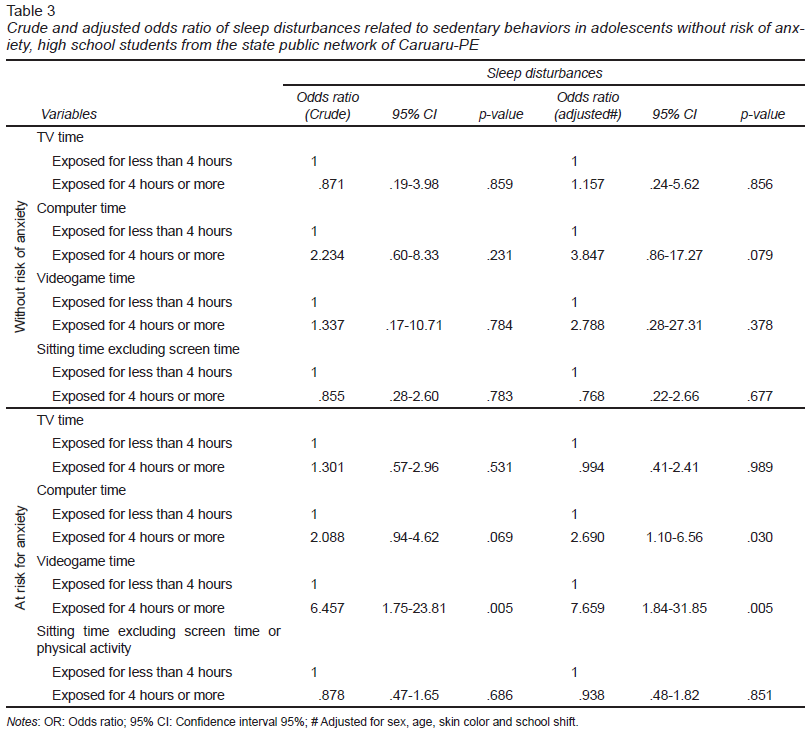Introduction
Sedentary behavior comprises low energy demand actions performed in a sitting, reclining, or lying position during the wakefulness (Tremblay et al., 2011). The increase in sedentary behavior and unhealthy lifestyles in adolescence is harmful and can have negative consequences for health in adulthood (Gordon-Larsen, Nelson, & Popkin, 2004), which highlights the importance of fighting some behaviors early on. Among the sedentary behavior indicators is the time of exposure to sedentary screens, which includes the use of various devices such as: television, tablets, computers, video games, and cell phones (Thomas, Bennie, De Cocker, Castro, & Biddle, 2020; Wu et al., 2017). High screen time combined with a low level of physical activity is associated with an increase in psychological problems (Cao et al., 2011).
Screen-based technology is exponentially evolving insofar children and adolescents are often involved with different types of screens and exploring different content (Guerrero, Barnes, Chaput, & Tremblay, 2019). Specifically in adolescents, the increased exposure time to a sedentary screen negatively affects their sleep quality (Guerrero et al., 2019), which can cause insomnia and/or daytime sleepiness and negatively impact daily activities, including school performance (Batista et al., 2018) and some psychological problems such as depression and anxiety (Brand et al., 2016; Maras et al., 2015). Among Brazilian adolescents, it was identified that 28.0% had a moderate level and 23.6% had a severe level of anxiety (Lopes & Rezende, 2013). A longitudinal study found a bidirectional association between increased use of computer/video games and anxiety in adolescentes (Zink, Belcher, Kechter, Stone, & Leventhal, 2019).
Gomes et al. (2017) evaluated 309 adolescents aged 10 to 19 years and found that the symptoms of anxiety and stress in this group were associated with poor sleep quality, corroborating studies which observed a bidirectional relationship between sleep quality and anxiety (Ghrouz et al., 2019; Uhde, Cortese, & Vedeniapin, 2009). The prevalence of poor quality and insufficient sleep duration among Brazilian adolescents is 28.2% (Gomes et al., 2017) and 12.6% (Neto et al., 2021), respectively. The relationship between sedentary screen time and sleep quality can be mediated by the level of anxiety in adolescents. Thus, it is important to assess how different screen types are related to emotional and behavioral health indicators such as sleep.
Moreover, in being aware that anxiety may be in the causal chain of the relationship between sedentary screen time and sleep, we question the existence of the association between time and sedentary screen type and the quality of sleep, regardless of the symptoms of anxiety, since few studies that investigated this relationship considered anxiety in their analyzes.
In view of the above, the objective of this study was to analyze the association between sedentary screen time and sleep quality, considering the level of anxiety as a moderating factor in adolescents of both genders.
Method
Design of the study
This is a quantitative, observational, and analytical study integrating the school-based cross-sectional epidemiological survey and municipal coverage. The Strengthening the Reporting of Observational Studies in Epidemiology (STROBE) standardised reporting guidelines for cross-sectional studies were followed for this study (von Elm et al., 2008).
Description of the sample
The target population consisted of adolescents of both genders aged between 14 and 19 years old and enrolled in high public schools of Caruaru-Pernambuco (PE). A total of 10,033 students were enrolled and distributed in 15 schools in the municipality according to the Pernambuco Education Information System, which provides information about public schools in the state of Pernambuco.
The sample size was calculated using the Sample XS software (http://www.brixtonhealth.com/samplexs.html, Accessed on 28 November 2021), and the following parameters were adopted for the calculation: 95% confidence interval; maximum tolerable error of 5 percentage points; drawing effect (deff) = 1.5, and the case study including analysis of multiple risk behaviors and different occurrence frequencies set to an estimated prevalence of 50%. Additionally, it was decided to increase the sample size by 20% in order to mitigate the limitations imposed by eventual losses in the application and/or inadequate filling of the questionnaires.
A two-stage cluster sampling procedure was used to select the required sample, and the school and class respectively represented the sampling units in the first and second stages. All state public schools in Caruaru-PE were considered eligible for inclusion in the study. In the first stage, the density of schools in each micro-region of the city (Center, North and South) according to size (small ≤ 200 enrolled students; medium > 200 – 499; and large ≥ 500) was adopted as a stratification criterion.
Nine schools were selected in proportion to their size, ensuring that at least 50% of the schools of each size were selected (2 large, 4 media, and 3 small). In the second stage, the density of classes in schools selected by period (day and night) and year (1st, 2nd, and 3rd year of high school, containing a greater number of adolescents aged between 14 and 19 years old) was considered as criteria for selecting those classes in which the questionnaires would be applied. These were applied between the months of September and November 2017.
Measurements
Socioeconomic and sociodemographic variables were assessed by the translated and adapted version of the Global School-based Student Health Survey (GSHS), proposed by the World Health Organization (WHO). Sedentary behavior was assessed using the weighted average of the following questions: “On school days (Monday to Friday), how many hours a day do you watch TV?,” and “On weekends (Saturday and Sunday), how many hours a day do you watch TV?” (Question 1 X 5 + question 2 X 2/7).
We similarly determined computer time and the weighted average of the questions: “On school days (Monday to Friday), how many hours per day do you use the computer?,” and “On weekend days (Saturday and Sunday), how many hours per day do you use the computer?.” Video game time was also evaluated by the weighted average of the questions: “On school days (Monday to Friday), how many hours per day do you play video games?,” and “On weekend days (Saturday and Sunday), how many hours per day do you play video games?”
The time spent sitting variable (except the screen exposure time) was evaluated by the weighted average of the questions: “On school days (Monday to Friday), how much time do you spend sitting, chatting with friends, playing cards or dominoes, talking on the phone, driving or as a passenger, reading or studying (not considering time watching TV and using a computer)” and “On weekend days (Saturday and Sunday), how much time do you spend sitting, talking with friends, playing cards or dominoes, talking on the phone, driving or as a passenger, reading or studying? (Do not consider time watching TV and using computer).”
Symptoms of anxiety were obtained through the Hospital Anxiety and Depression Scale (HADS) where signs of anxiety were assessed using a previously validated questionnaire for the adolescent population (Cronbach’s Alpha coefficients: .84; Bjelland, Dahl, Haug, & Neckelmann, 2002; Faro, Araújo, Maciel, Lima, & Souza, 2021). The HADS classifies the anxiety and depression level and is composed of 14 multiple choice questions where the even questions assess the level of depression and the odd questions assess anxiety. The cut-off point was ≥ 9 (White, Leach, Sims, Atkinson, & Cottrell, 1999), categorizing the group into risk-free and at risk of presenting symptoms of anxiety (Teychenne & Hinkley, 2016).
Sleep quality was obtained using the Pittsburgh Sleep Quality Index (PSQI; Buysse, Reynolds, Monk, Berman, & Kupfer, 1989), standardized and previously validated for the Brazilian Portuguese language (Bertolazi et al., 2011) and for the adolescent population (Cronbach’s alpha coefficients: .71; intraclass correlation coefficient: .65; Passos et al., 2017). A cut-off score of 0-4 points for good quality sleep was used, 5-10 points for poor sleep quality, and sleep disturbances were classified for scores above 10 points (Chellappa & Araujo, 2007; Schlarb, Friedrich, & Claßen, 2017). The use of these cut-off points was based on a recent systematic review that highlights that the cut-off point 5, used for PSQI, has a low sensitivity in the identification of sleep disorders than higher cut-off points (Fabbri et al., 2021).
Procedure
All students in the selected classes were invited to participate in the study, regardless of their age. Informed consent was obtained for all participants. The parents or guardians of the adolescents were invited to sign a consent form, with the consent signed by the guardian, the adolescent interested in participating, also signed a term declaring their agreement to participate in the research.
Questionnaires answered by students under 14 and over 19 years old were excluded after application. The questionnaires were applied in the classroom in the form of a collective interview without the presence of teachers. Students were continuously assisted by five researchers (two professors and three undergraduate students) to clarify doubts when filling out the form questionnaires.
Statistical analyses
The final tabulation of the data was performed using the EPIDATA program version 3.1 (http://www.epidata.dk/download.php/downloads/php/php/downloadc.php?file=setup_epidata.exe#ee; accessed on 28 November 2021). Data entry was repeated and typing errors were detected and corrected using the duplicate file comparison function.
Distribution frequency was observed in the descriptive analysis. The Pearson’s chi-squared test was used (χ2) in the inferential analysis in order to analyze the association between sedentary behavior, sleep quality, and anxiety in adolescents; explore possible confounding factors; and identify the need for statistical adjustment of the analyzes. We used logistic binary regression in the multivariate analysis estimated by the odds ratio (odds ratio = OR) and 95% confidence intervals to express the degree of association between the dependent variable (sleep quality) and the independent variables (sedentary behaviors), controlling possible confounding variables such as sex, age, skin color, and school shift. In addition, the interaction test with the anxiety level was performed, which was considered as a moderating variable (effect modifiers; Bauman, Sallis, Dzewaltowski, & Owen, 2002). Thus, each statistical model was carried out in a stratified manner (without risk of anxiety and at risk for anxiety).
The Student’s t-test and Pearson's linear correlation between the sleep quality and symptoms of anxiety variables were also applied. The significance level adopted for all tests was p < .05, and all analyzes were performed using the SPSS statistical software (version 21.0).
Ethical considerations
This study followed the agreements of the National Health Council, approved by the Human Research Ethics Committee of the Centro Universitário Tabosa de Almeida (Asces-Unita) number: (CAAE-22210913.8.0000.5203/CEP-ASCES: 072403/2013).
Results
A total of 687 students from nine schools in the municipality of Caruaru-PE, were interviewed. The final sample was 666 adolescents after 14 refusals by parents and students, and the exclusion of seven questionnaires from students under the age of 14 and over 19, where most were female (53.1%), aged between 16 and 17 years (63.6%), who studied during the day (80.3%), did not work (62.9%), and had maternal education of less than or equal to eight years of study (90.4%). The prevalence of sleep disturbances among adolescents was 10.4%, of which 76.5% were at risk of having anxiety symptoms. The other socio-demographic and sedentary behaviors characteristics of the adolescents are shown in Tables 1 and 2. It must be emphasized that some variables have a lower quantity than the final sample, since, in order to respect their ethical rights, some students chose not to answer some questions, classified as missing.
Figure 1 shows the positive correlation (p < .001) of sleep quality and symptoms of anxiety (Pearson's correlation, r = .393) of adolescents.
After the interaction test and verification of the anxiety level as a moderating variable, the results of the crude and adjusted odds ratio for the explicative variables (gender, age, skin color, and school shift) were stratified by the anxiety level of adolescents (without risk of anxiety and at risk of anxiety). After adjustment, sleep disorder was significantly associated with computer exposure time (OR = 2.337; CI 95% [1.01, 5.43]) and video game (OR = 8.083; CI 95% [2.0, 32.8]) only in adolescents at risk of anxiety symptoms, as shown in Table 3.
Discussion and conclusion
The aim of this study was to analyze the association between sedentary screen time and sleep quality, regardless of the symptoms of anxiety in adolescents of both genders. Among the main results, we can highlight: a) a low prevalence of exposure to sedentary screen time; b) a strong correlation between the sleep quality and the symptoms of anxiety; c) after adjusting for different confounders, a significant association was found only between exposure time to screens of interactive devices (computer and video game) and sleep quality, only in adolescents with risk of having symptoms of anxiety.
The prevalence of adolescents exposed to more than four hours of television and computers was 12% and 15.4%, respectively. This prevalence is low when compared to the prevalence presented in systematic reviews studies (Guerra, Farias Júnior, & Florindo, 2016; Silva, Soares, Silva, & Tassitano, 2016) and recent meta-analyses (Schaan et al., 2019). This difference can be partly explained by the cut-off point adopted in the present study, highlighting the lack of a standardized cut-off point in the national literature which aims at an adaptation to determine the exposure to sedentary screen time (Guerra et al., 2016).
The American Academy of Pediatrics recommends that children and adolescents limit their total screen-based entertainment time to a maximum of two hours a day (Council on Communications and Media, 2013). However, nowadays adolescents spend more time on sedentary activities based on screen studying or for entertainment (Schaan et al., 2019) due to the high availability of technological devices, so it is important that this cut-off point be reviewed and monitor the access to technological devices by children and adolescents.
As seen in the present study, the association between screen exposure and sleep in adolescents is commonly observed (Silva, Oliveira, Santos, & Tassitano, 2017), and this relationship maybe explained by the fact that an excessive exposure to the blue light of the screen can suppress melatonin production, altering aspects of the circadian cycle and increasing mental and physiological arousal (Cajochen et al., 2011; Wahl, Engelhardt, Schaupp, Lappe, & Ivanov, 2019). The wavelength of the blue light emitted and the viewing distance from the screen can influence the impact that this blue light may have on sleep (Komada, Aoki, Gohshi, Ichioka, & Shibata, 2015; Yoshimura et al., 2017). However, the present study did find a significant association between sleep quality and exposure to sedentary screen time only in devices with more interaction (computer and video games). The higher use of these devices is associated with a higher level of anxiety (Moge & Romano, 2020; Zink et al., 2019), which can impair the quality of sleep. In addition, excessive use can develop dependence and also influence sleep. It should also be noted that some adolescents emphasize that TV may to help fall asleep (Eggermont & Bulck, 2006), thus partly explaining the non-association between this electronic device and poor sleep quality. This non-association can also be related to the viewing distance from the TV, which is usually greater than other devices.
The interaction pattern of allied devices including the use of social networking seems to impact the sleep quality and anxiety in adolescents (Aros, Germano-Soares, Silva, Silva, & Tassitano, 2017; Silva et al., 2014). For example, in a study conducted by Espinoza and Juvone (2011) with 268 young adolescents, it was found that 37% reported having lost sleep due to the use of social networking sites. In this sense, greater interactivity and a multitude of access possibilities, including computer games, may influence usage patterns and stimulated physiological responses in relation to the central nervous system, increasing the state of excitation, and impairing sleep patterns (Dworak, Schierl, Bruns, & Struder, 2007; Instituto Brasileiro de Geografia e Estatística, 2013).
Corroborating the findings of this study regarding video games, a recent systematic review (Peracchia & Curcio, 2018) found that playing video games at night may delay the onset of sleep and interfere with the duration and sleep efficiency by changing its architecture and temporal structure, directly affecting the quality of adolescents’ sleep. It is noteworthy that the intensity (Altintas, Karaca, Hullaert, & Tassi, 2019) and the type of game (violent, exciting, competitive) can also interfere with the sleep pattern (Koepp et al., 1998).
As previously detected (Ghrouz et al., 2019), the present study also observed a negative relationship between anxiety and sleep quality. However, an intriguing fact was that the relationship between screen exposure, specifically in those interacting behaviors, and sleep quality was only found in those with high symptoms of anxiety. In this sense, the higher interaction with the screen plus the higher level of anxiety can be more damaging to sleep.
Constant message alerts put considerable pressure on being available 24/7 days a week and contribute to the fear of missing the content of these messages (Thomée, Dellve, Härenstam, & Hagberg, 2010), which may in turn bring about symptoms of anxiety and altered sleep patterns. Thus, teenagers who already have a high level of anxiety, in addition to behaviors with a high degree of stimulation, may have their sleep quality even more impaired. In a study by Woods and Scott (2016), the increase in the general use of social media, specifically night use of social media and the emotional investment in these media were associated with worse sleep quality and higher anxiety and depression levels, constituting a fact which may somehow explain the results found.
This study has limitations which deserve to be mentioned such as there was no controlled screen exposure time, the form of computer use (study, work, or entertainment), bedtime and chronotype-related adolescent sleep (morning, intermediate and evening). Among the strengths of this study, we can highlight the representative sample of high school students in the municipality and the originality of the analysis, considering the symptoms of anxiety and the different types of exposure to the screen, in addition to controlling intervening variables such as gender, age, and school shift.
It is concluded that exposure to screen time, specifically those have greater interaction, such as video games and computers, can have a negative impact on sleep quality, and this relationship was only found in those with a higher risk of anxiety, regardless of gender, age, and school shift. Thus, it is highlighted that interactivity plus anxiety can potentiate the negative effects related to sleep in adolescents.



